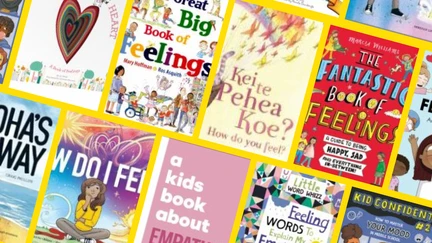Dealing with big feelings: What to read after watching Inside Out 2
Do our emotions control us? Or do we control our emotions? Do our memories and beliefs form our own sense of self?

These questions and more are asked, and answered, by the movie Inside Out and its sequel, Inside Out 2.
Inside Out
Produced by Pixar and released by Walt Disney Pictures, Inside Out is set in the mind of a young girl, Riley Andersen (Kaitlyn Dias), where five personified emotions—Joy (Amy Poehler), Sadness (Phyllis Smith), Fear (Bill Hader), Anger (Lewis Black), and Disgust (Mindy Kaling)—try to lead her through life as her parents (Diane Lane and Kyle MacLachlan) move the family to a new city.
Overall, this is a cute movie that provides a very funny interpretation of what happens in the human mind when emotions set in, what roles each our emotions play in our personalities, how we communicate and form relationships with people.
Some very funny moments in the film, especially when Anger loses his temper, Disgust’s sarcastic and cynical behaviour and finding what role Sadness plays in our lives (Spoiler: it's a very important role indeed).
Rating: 8/10
For a sneak peek of Inside Out, check out the trailer here.
Inside Out 2
Inside Out 2 returns with Riley Andersen (Kaitlyn Dias), and her five main and personified emotions—Joy (Amy Poehler), Sadness (Phyllis Smith), Fear (Tony Hale), Anger (Lewis Black), and Disgust (Lisa Lapira).
However, a spanner is thrown into the works.
Riely has turned 13. The puberty alarm sets off, welcoming new and complex emotions in the form of Anxiety, Envy, Embarrassment, and Ennui (French for boredom). This creates further challenges for Riely as she navigates through more life changes, such as transitioning from a child to an adolescent, going to a different school from her existing friends, forming new friendships and more importantly her sense of self.
A further complication emerges where Joy and Anxiety have different views and clash on Riley’s identity and how navigates her teenage years, friendships, etc.
Therefore, Anxiety forms a munity, (literally “bottles” and “suppresses” the main emotions), and sabotages (or should I say “self-sabotages”) Riley’s sense of self, identity, and at times, moral code where she is second guessing herself, ultimately gaslighting her into thinking she’s not good enough and that she will always be alone. Poor Riley is continuously trying to prove her worth with disastrous consequences.
What is interesting to note about this film, is neither Joy nor Anxiety had the right idea about what was in Riley’s best interests. It was up to Riley to accept herself as a multifaceted personality of various depths neither good nor bad more importantly what makes us human.
Overall, this film was in a word… brilliant! Better and more hilarious than the original film! Anxiety is hilarious and psychotic as a personification of nerves and energy and an antagonist you will love to hate… and perhaps think twice about. Embarrassment is a big teddy bear you want to hug and Ennui is just as dry and sarcastic as Disgust.
Speaking of sarcastic, the “sar-chasm” is both hilarious and serves as a powerful metaphor in the film.
This film also serves as a good lesson of how a powerful union of memories and beliefs form a person and learning to accept and love yourself as you are.
Check out the trailer here. Keep an eye on our catalogue for when this movie is released on DVD.
Rating: 10/10
If you’re looking for books to give you more insight into how our emotions work, why not have a read of the following books:
- In my heart : a book of feelings by Jo Witek.
- The great big book of feelings by Mary Hoffman.
- Kei te pehea koe! = How do you feel by Tracy Duncan
- My mixed emotions : learn to love your feeling by Elinor Greenwood
- The fantastic book of feelings: a guide to being happy, sad and everything in-between by Marcia Williams.
- Big feelings : and what they tell us by Rebecca Ballagh
- How do I feel? : a dictionary of emotions for children: with 60+ definitions to help children identify and understand their emotions by Rebekah Lipp
- A kids book about empathy by Daron K Roberts
- Feeling words to explain my emotions by Emily Sharratt
- How to master your mood in middle school by Lenka Glassman
- Let it flow : healthy ways to release emotions by Rebekah Lipp
- Aroha’s way by Craig Phillips
- Ups and downs : a book about big feelings by Karen Young
Search our catalogue for more books about emotions.